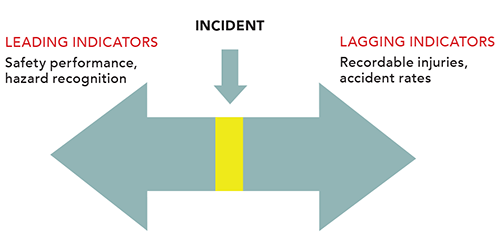The Campbell Institute: What are safety leading indicators?

The Campbell Institute at the National Safety Council is the EHS center of excellence. Built on the belief that EHS is at the core of business vitality, the Institute seeks to help organizations, of all sizes and sectors, achieve and sustain excellence. Learn more at thecampbellinstitute.org.
We humans love to measure everything. Some measurements, like the gas gauge in our car showing how much fuel is remaining, are fantastic. There is a direct correlation with the level of fuel in the tank with having enough fuel to get to where you are going.
Some measurements are not so great, such as with traditional safety measures. Why? Safety traditionally looks at one metric – injuries – to answer the question, “Is it safe?” Unfortunately, this is only a one-dimensional measurement. It can be said that many injuries denotes an issue with a safety program. On that we can agree that success cannot exist if many workers are getting hurt. However, if no workers are getting hurt, does this then imply that all is safe? Perhaps yes and perhaps no. Zero injuries could be the result of a well-executed plan with an equally rigorous process of implementation where the work occurs. However, zero could also be due to sheer luck.
In effect, a balanced approach is necessary. Injuries – or the lack thereof – are a very important measurement. Safety exists to ensure workers go home safely each day. However, it is also important to understand if work is being done safely. Can you determine if you are truly good or simply lucky? In terms of recent vernacular, these two opposing metrics used to create a balanced scorecard are called leading and lagging safety indicators.
The Campbell Institute at the National Safety Council has defined leading indicators as such:
“Proactive, preventative, and predictive measures that monitor and provide current information about the effective performance, activities, and processes of an EHS management system that can drive the identification and elimination or control of risks in the workplace that can cause incidents and injuries.”
This is a good definition, yet I wish to simplify it even further:
“Safety leading indicators are proactive measures that measure prevention efforts and can be observed and recorded prior to an injury. As opposed, safety lagging indicators are reactive measures that track only negative outcomes, such as an injury, once it has already occurred.”
Looking at the gas gauge analogy, the gas gauge readings are leading indicators. A low fuel light coming on is a leading indicator. The activity of stopping and putting fuel in the vehicle is a leading indicator. Running out of gas due to an empty gas tank is a lagging indicator. This is an overly simplistic example, but it is certainly effective in showing the delineation between prevention and reaction to an incident.

Unlike lagging indicators, for which everyone has adopted a shared definition and calculation of injury rates, leading indicators are many and varied. Although there are numerous specific leading indicators that can be collected, it is easiest to categorize them into specific functionality, as shown below:
- Observation-based (behaviors/environment) – This can be defined as a specific instance of a behavior or condition that can be assessed to determine the risk of injury. Examples of leading indicators can include safe observations, unsafe observations and participation.
- Operations-based – This can be defined as indicators that relate to the functioning of an organization’s infrastructure. Examples can include schedule/productivity influences, risk assessments, risk mitigation through improved Hierarchy of Controls, preventive maintenance, training efforts and timely closure of open safety issues.
- Systems-based – This can be defined as indicators that relate to the management of a safety system. Examples can include management commitment efforts, psychosocial aspects (e.g., interpersonal relationships, fear and stress), culture and design.
Adoption of leading indicators as an inclusion in a balanced scorecard approach should span the breadth of each of these categories in some way, shape or form. For example, simply focusing on a behavior observation program while neglecting behavioral drivers from operations and systems would likely yield limited long-term improvements in the prevention of injuries.
Safety professionals and the organizations they work in make great efforts to create detailed and intricate health and safety plans. These plans exist to detail the methods – rules, processes, activities and equipment – that will be used to protect workers and prevent injuries. However, a plan is just paper and is completely different than the process – what actually occurs at the point of work. It is assumed that the process and the plan are aligned, yet often that is not the case. Leading indicators are simply ways to measure the alignment between the plan and the process so that actions can be made to adjust and correct before an injury occurs. In reality, it is not the adoption of leading indicators or the collection of leading indicators that lead to improvement; it is the actions taken with the information that determine success.
This article represents the independent views of the author and should not be construed as a National Safety Council endorsement.
 Cary Usrey is a Process Improvement Leader at Predictive Solutions, a member of the Campbell Institute. In this role, Usrey is responsible for implementing solutions and best practices for customers seeking to prevent worker injuries. He coaches customers through an assessment, goal-setting and goal measurement process that is designed to maximize safety improvement and widespread organizational engagement. He can be reached at [email protected].
Cary Usrey is a Process Improvement Leader at Predictive Solutions, a member of the Campbell Institute. In this role, Usrey is responsible for implementing solutions and best practices for customers seeking to prevent worker injuries. He coaches customers through an assessment, goal-setting and goal measurement process that is designed to maximize safety improvement and widespread organizational engagement. He can be reached at [email protected].
Post a comment to this article
Safety+Health welcomes comments that promote respectful dialogue. Please stay on topic. Comments that contain personal attacks, profanity or abusive language – or those aggressively promoting products or services – will be removed. We reserve the right to determine which comments violate our comment policy. (Anonymous comments are welcome; merely skip the “name” field in the comment box. An email address is required but will not be included with your comment.)

